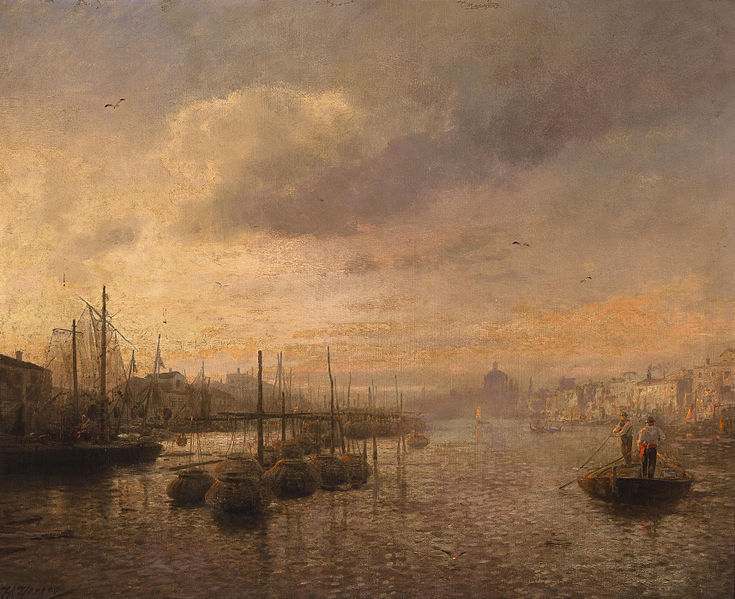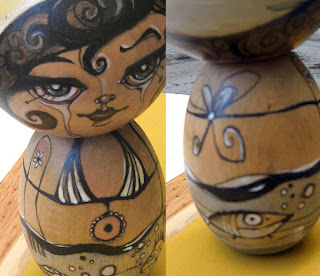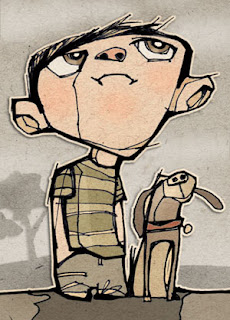By James Grant
Plato famously said that there is an ancient quarrel between philosophy and poetry. But with respect to one aspect of poetry, namely metaphor, many contemporary philosophers have made peace with the poets. In their view, we need metaphor. Without it, many truths would be inexpressible and unknowable. For example, we cannot describe feelings and sensations adequately without it. Take Gerard Manley Hopkins’s exceptionally powerful metaphor of despair:
selfwrung, selfstrung, sheathe- and shelterless,
thoughts against thoughts in groans grind.
How else could precisely this kind of mood be expressed? Describing how things appear to our senses is also thought to require metaphor, as when we speak of the silken sound of a harp, the warm colours of a Titian, and the bold or jolly flavour of a wine. Science advances by the use of metaphors – of the mind as a computer, of electricity as a current, or of the atom as a solar system. And metaphysical and religious truths are often thought to be inexpressible in literal language. Plato condemned poets for claiming to provide knowledge they did not have. But if these philosophers are right, there is at least one poetic use of language that is needed for the communication of many truths.
In my view, however, this is the wrong way to defend the value of metaphor. Comparisons may well be indispensable for communication in many situations. We convey the unfamiliar by likening it to the familiar. But many hold that it is specifically metaphor – and no other kind of comparison – that is indispensable. Metaphor tells us things the words ‘like’ or ‘as’ never could. If true, this would be fascinating. It would reveal the limits of what is expressible in literal language. But no one has come close to giving a good argument for it. And in any case, metaphor does not have to be an indispensable means to knowledge in order to be as valuable as we take it to be.
Metaphor may not tell us anything that couldn’t be expressed by other means. But good metaphors have many other effects on readers than making them grasp some bit of information, and these are often precisely the effects the metaphor-user wants to have. There is far more to the effective use of language than transmitting information. My particular interest is in how art critics use metaphor to help us appreciate paintings, architecture, music, and other artworks. There are many reasons why metaphor matters, but art criticism reveals two reasons of particular importance.

Take this passage from John Ruskin’s The Stones of Venice. Ruskin describes arriving in Venice by boat and seeing ‘the long ranges of columned palaces,—each with its black boat moored at the portal,—each with its image cast down, beneath its feet, upon that green pavement which every breeze broke into new fantasies of rich tessellation’, and observing how ‘the front of the Ducal palace, flushed with its sanguine veins, looks to the snowy dome of Our Lady of Salvation’.
One thing Ruskin’s metaphors do is describe the waters of Venice and the Ducal palace at an extraordinary level of specificity. There are many ways water looks when breezes blow across its surface. There are fewer ways it looks when breezes blow across its surface and make it look like something broken into many pieces. And there are still fewer ways it looks when breezes blow across its surface and make it look like something broken into pieces forming a rich mosaic with the colours of Venetian palaces and a greenish tint. Ruskin’s metaphor communicates that the waters of Venice look like that. The metaphor of the Ducal palace as ‘flushed with its sanguine veins’ likewise narrows the possible appearances considerably. Characterizing appearances very specifically is of particular use to art critics, as they often want to articulate the specific appearance an artwork presents.
A second thing metaphors like Ruskin’s do is cause readers to imagine seeing what he describes. We naturally tend to picture the palace or the water on hearing Ruskin’s metaphor. This function of metaphor has often been noted: George Orwell, for instance, writes that ‘a newly invented metaphor assists thought by evoking a visual image’.
Why do novel metaphors evoke images? Precisely because they are novel uses of words. To understand them, we cannot rely on our knowledge of the literal meanings of the words alone. We often have to employ imagination. To understand Ruskin’s metaphor, we try to imagine seeing water that looks like a broken mosaic. If we manage this, we know the kind of look that he is attributing to the water.
Imagining a thing is often needed to appreciate that thing. Knowing facts about it is often not enough by itself. Accurately imagining Hopkins’s despondency, or the experience of arriving in Venice by boat, gives us some appreciation of these experiences. By enabling us to imagine accurately and specifically, metaphor is exceptionally well suited to enhancing our appreciation of what it describes.
James Grant is a Tutorial Fellow in Philosophy at Exeter College, Oxford. He is the author of The Critical Imagination.
Subscribe to only philosophy articles on the OUPblog via email or RSS.
The post Why metaphor matters appeared first on OUPblog.















"Me first, me first!" I'm in this week with my favorite YouTube of the week,"What Teachers Make," by Taylor Mali.
Thanks for hosting, Mary Lee. Your manly reinterpretation of Gerard's poem is grand!
Thanks, Mary Lee.
With all the turmoil going on in the world right now, I thought your readers might enjoy "Be Still in the World" at The FATHER GOOSE Blog
I missed out on Poetry Friday last week and am sad now that I didn't get to read Pied Beauty...but your wonderful poem makes up for it. Thanks for sharing and thanks for hosting.
This week my Women's History Month Poetry Countdown continues with #4...
http://thesmallnouns.blogspot.com/2011/03/poetry-friday-womens-history-month_24.html
Ben @ The Small Nouns
Thanks for hosting, Mary Lee!
My contribution is in remembrance of the young women who perished at the Triangle Shirtwaist Factory one hundred years ago today:http://tmsteach.blogspot.com/2011/03/poetry-fridayslice-of-life-march.html
Wow, Mary Lee--loved Pied Beauty and your faithful take on it. Thanks for hosting this week!
Over at TeachingAuthors I've included a poem thanking a school(and one woman there) for giving me the most amazingly wonderful school visit thank you gift I've ever been given.
www.TeachingAuthors.com
Mary Lee, Thank you for hosting! "They maintain sanity whose beauty is past lunacy..." Yes! Your words remind me happily of John Agard's poem "Prayer to Laughter."
With eating words on the brain, today I am in with #11 of my book poem series - "Eating Reading."
http://poemfarm.blogspot.com/2011/03/poetry-friday-eating-books-in-poem-359.html
What a fun poem, Mary Lee! It's not every day you read a poem with a tribute to junk food in it :-) And all the comments above me look great, too. I've got The Sun Grows In Your Smile: http://tabathayeatts.blogspot.com/2011/03/sun-grows-in-your-smile.html
Wow, this is looking like a great Poetry Friday already and I can see I'm going to be very distracted by everyone's post. At the end of a long week of not qute getting there (just had a "You forgot..." phonecall from Little Brother's School) your poem is a joy and shall be implemented this week-end :-)
My post this week is a call for haiku from artist Laurie Halsey Brown who is taking an exhibition to Japan in October...
Thank you for hosting.
Thanks for hosting. At 100 Scope Notes I have a new book spine poem: http://100scopenotes.com/2011/03/25/poetry-friday-hardy-boys/
Thank you so much Mary Lee. I think you have caught Hopkins music and turned it to bright use. I was feeling gloomy and bedraggled, but that was the perfect antidote.
"At the Storm Door" is what I offer today
http://blythewoolston.blogspot.com/2011/03/at-storm-door.html
How fun is THAT? Thank you for sharing it!
Here's my post for today. It's "Sutra," by Marilyn Krysl.
Thanks for hosting, Mary Lee, and for treating us to your fun remake of Pied Beauty. I have an original poem about late snow (ugh) at The Writer's Armchair today.
Hi Mary Lee! Thanks for your poem--I need a little silliness this morning.
I would love to participate in your April project, too.
Today I share a poem called "The Little Ships" at Random Noodling
Kurious Kitty has a poem by Jakushitsu, "Wild Geese Among the Reeds. " Kurious K's Kwotes' P.F. quote is by Jakushitsu.
And, at The Write Sisters I have a little Emily Dickinson spring poem, despite the fact that it is in the 20's right now. Brrrrr.
Hi, everyone! I'm back after a long break (busy editing).
To celebrate spring, I'm sharing "The Greener Forest." It's the title poem of fantasy author Vonnie Winslow Crist's just-published book. You'll want to run outside, put your toes in the grass and hunt for faery rings after reading this poem.
http://authoramok.blogspot.com/2011/03/poetry-friday-make-believe.html
thanks for hosting! i've got an original poem this week, a list full of silly trees whose lunacy i hope is praiseworthy.
http://fomagrams.wordpress.com/2011/03/25/poetryfriday-the-fruits-of-trees-no-god-created/
A haiku by Issa on the impermanence of things:
http://pentiment.blogspot.com/2011/03/poetry-friday-this-dewdrop-world.html
I'm in with a David Whyte poem. Apparently he is really well known, but I didn't know his work at all.
Love your poem-- I need some of this silliness in my life right now!
Hi Mary Lee--I've missed PF the past few weeks. Too much chaos at my end! Happy to be back today with "Memory" from Tracie Vaughn Zimmer's new Cousins of Clouds: Elephant Poems at http://laurasalas.livejournal.com/267962.html
And 15 Words or Less are up at http://laurasalas.livejournal.com/267758.html
Thanks for hosting!
Ha! If you saw my "frisbee flings" you would think them silly indeed---they tend to bounce on the ground. I LOVE your take on this, and will praise three silly things in your honor today. :)
My Poetry Friday contribution is "I Used To Know Her Name," a poem I drafted last week in response to Laura Purdie Salas and Susan Taylor Brown's new online weekly poetry book club.
I LOVE "Wild Atrocity!" So glad you shared it again.
This week I'm doing a little Spring cleaning in anticipation of my Poetry Potluck in April with a poem by Marilyn Annucci:
http://jamarattigan.livejournal.com/523631.html.
Smile and say, "Cheese!"
Thanks for hosting!!
Good morning! I have Lullaby by Christina Rosetti on my blog this morning.
Hi, Mary Lee, thanks for hosting. I'm in today with a review of J Patrick Lewis' new easy reader series.
Have a great weekend!
Happy Poetry Friday! On The Stenhouse Blog we have April by Alicia Ostriker. Enjoy!
Happy Friday! Here's my poetry Friday post: http://sharingsoda.blogspot.com/2011/03/poetry-friday-2-review-tree-that-time.html
Thanks for hosting!
Thanks for hosting today! I'm in with Won Ton: A Cat Tale Told in Haiku by Lee Wardlaw (Author) and Eugene Yelchin (Illustrator)http://wp.me/pWySC-bm
Thanks for rounding us up Mary Lee! I love your poem. I need to remember those things when I am getting exasperated by business and rushing. You have given me some joy! Hopkins is a favorite of mine, too.
I want to be part of your Poetry tag game in April! I am learning what fun QR codes can be so that sounds wonderful!
I have some Basho cherry blossom haiku for today.
Thanks for hosting, Mary Lee!
I am in with my translation of Das Erste Veilchen by Karl Egon Ebert. http://kellyrfineman.livejournal.com/687647.html.
Thank you for hosting on this glorious spring day here in northern Virginia! I have shared a haiku by a Washington Post reader which is featured on the cover of the Weekend magazine that has a "guide to all things cherry blossom" today.
http://bit.ly/fYEfCy
Thanks for the "Wild Atrocity" poem. I LOVE silly things. In fact--I AM a silly thing!
At Wild Rose Reader, I have Crocus Poems: Variations on a Theme. It includes three original poems that I posted before--along with rough drafts of two new porms that I wrote this morning.
http://wildrosereader.blogspot.com/2011/03/crocus-poems-variations-on-theme.html
Mary Lee, thank you for Wild Atrocity, and making me smile.
I wrote about a new verse novel set mostly in Japan, called Orchards by Holly Thompson at
http://jeannineatkins.livejournal.com/157330.html
Can't wait to see more of you in April!
At Blue Rose Girls, I have Silkworm Cocoon & Pupa Poems: Variations on a Theme. (They are all original poems.)
http://bluerosegirls.blogspot.com/2011/03/silkworm-cocoon-pupa-poems-variations.html
(Oops -- mistyped my link ....)
Thanks for hosting, Mary Lee. Enjoyed your giddy take on GMH. :)
I'm in this week with a Mark Jarman poem, and it's here.
Thanks for hosting and for sharing such a fun poem..although I have to admit I'm not wishing for any late-March snowball fights over here :)
My post today features the rhyming picture book My Many Colored Days...just in time to still celebrate the birthday month of Dr. Seuss.
http://kerryaradhya.blogspot.com/2011/03/poetry-friday-what-color-day-are-you.html
Thanks for hosting.
My selection is "Where Is Spring?" This poem was written by Taiwanese poet Yang Huan (1930-1954). He wrote only twenty poems in his lifetime, but is considered by many scholars to be one of the main influences on modern Chinese children's poetry. The book is illustrated by H.Y. Huang and A. Yang.
I'm in with an original haiku about cherry blossoms.
Thanks for hosting!
http://www.jenrothschild.com/2011/03/poetry-friday_25.html
Yes, praise all silly things! Thanks for your wonderful poem and for hosting, Mary Lee. I have Steve Kowit's "The Grammar Lesson" over at my blog today. Happy Poetry Friday!
http://marthacalderaro.wordpress.com/2011/03/25/poetry-friday-6/
Thank you for your work as host. What a great take on Hopkins genius. :) You made me smile.
I am sharing a post today with an original tanka about the noise of spring.
http://twinklingalong.blogspot.com/2011/03/poetry-friday-spring-tanka.html
Well, I'm late to the party but here I am!!
I have another sneak peak with student pomes for National Poetry Month.
Mary Lee,your take on Hopkins' Pied Beauty is chock full of fun images. Japan is still on my mind, so I offer an original Haiku at my Musings blog.
http://[email protected]
I look forward to meandering through all the wonderful poems offered up today!
I'm late, but better late then never! Here's my post http://booksdogsandfrogs.wordpress.com/2011/03/25/the-duck-and-the-kangaroo/ with some Edward Lear for a nonsensical day.
Sarah
Sorry so late. Today I'm featuring John Donne and his poetry and poetic sermons: http://www.semicolonblog.com/?p=4688
My poem this week is WANDERERS by Walter de la Mare, in honor of my WIP-- middle grade historical fiction (set in 1548 Bruges and Brussels) where the main character is the daughter of an astronomer. "Wanderers" are what the planets were called in the night sky during the middle ages and renaissance. Enjoy!
http://nicolemarieschreiber.wordpress.com/2011/03/25/poetry-friday-wanderers-the-planets/
-Nicole Marie Schreiber
I forgot to add how much I liked "Wild Atrocity". I think I need that in from of me this coming week. The last week before spring break.
I'm hoping I can still get in! My contribution is a beautiful poem by the Irish Eavan Boland, White Hawthorn in the West of Ireland. Beautiful images!
http://happycatholic.wordpress.com/2011/03/26/poetry-friday-white-hawthorn-in-the-west-of-ireland/